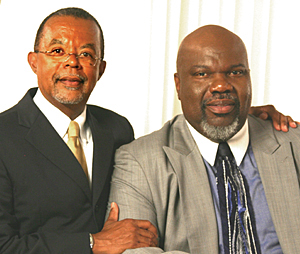

 |
“Understanding where you came from affects where you’re going,” the Rev. T.D. Jakes (right) tells host Henry Louis Gates Jr. (Photo: Graham Judd.) |
One part Nova, one part History Detectives and one part have-the-tissues-handy reality show, African American Lives is WNET’s big-buzz offering for Black History Month in 2006.
Over four hours, split between Feb. 1 and 8 [2006], the producers help eight prominent blacks — Quincy Jones, Whoopi Goldberg, astronaut Mae Jameson and neurosurgeon Ben Carson among them — discover their pasts through a combination of sophisticated DNA sampling and advanced genealogical research.
“DNA examinations of one kind or another are not new on public TV,” said William Grant, director of science, natural history and features programming for the New York station, which is co-producing the project with Kunhardt Productions. He notes that Journey of Man: A Genetic Odyssey, a National Geographic special, looked at migration patterns out of Africa using DNA records, and a 2002 episode of WNET’s Secrets of the Dead used DNA forensics to identify the remains of victims of the 1912 Titanic sinking.
“But what’s so unique about this series is that we go from big history to very personal histories,” said Grant. “It has this fascinating, personal, emotional quality to it.”
“I don’t think most Americans realize that we were a slave country for much longer than we’ve been a free one,” said Grant, who says the show should have appeal for all audiences, not just those of African descent. The Rev. T.D. Jakes, another one of those profiled in the show, puts it another way in the film: “America likes to think . . . slavery was a lot farther back than it really was. It was yesterday.”
Historian Henry Louis Gates Jr., no stranger to PBS (Wonders of the
African World, America: Beyond the Color Line), is the mastermind behind the project.
He had
edited a 2004 book of the same name, a compilation of 600 African-American
biographies, and was looking for a way to bring some of the stories to television.
It was
Kunhardt’s creative team that recognized that DNA profiling had advanced
to the point that at least some participants would be able trace their ancestry
back to specific regions of Africa, said Grant.
The producers worked with Ancestry.com, an Internet-based genealogy firm, to construct family trees for the eight role models profiled on camera, said Senior Producer Graham Judd. Outreach for the show will include a website that will show viewers how to use genealogical search engines to research their own histories. But many blacks will discover that the trail runs dry around the Civil War, because before 1870 blacks weren’t counted in the U.S. Census, he said.
In the show, once the archival records run out, DNA analysis steps in.
Thanks to work done by Rick Kittles, an Ohio State University professor whose
company,
African
Ancestry Inc., compiled a database of more than 20,000 lineages from 389
indigenous African populations, the producers can determine from saliva swabs
where in
Africa the celebrities’ ancestors came from. (For a few hundred dollars,
various firms offer DNA tests similar to the ones used in the project.)
The cameras follow comedian Chris Tucker and Gates as they make the pilgrimage back to the Central African village where Tucker’s kin lived.
Judd and Grant want to save the biggest reveals of their detective work for viewers, but Judd did divulge that one celebrity has a covered-up murder among relatives past, and a highlights reel hints that the white blood in Quincy Jones’s family tree is not the white slave owner story he’d always been told.
“These little stories, which are huge stories for us individually, collectively make up the narrative of our people,” Gates says in the film.
Web page
posted Nov. 3, 2005
Copyright 2005 by Current Publishing Committee
Geneva Collins is contributing editor and copy editor of Current.